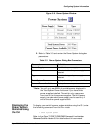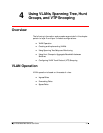
Cajun P550/P880/P882 Switch User Guide
Using VLANs, Spanning Tree, Hunt Groups, and VTP Snooping
4-3
Egress Rules
For a given port/VLAN combination, egress rules determine
whether frames transmitted from the port on the VLAN are tagged
or untagged. This is accomplished by setting the Trunking Mode
attribute in the Switch Port Configuration dialog box.
For example, choosing the IEEE 802.1Q trunk mode causes all
frames transmitted out of the port to be tagged using the IEEE
802.1Q tag header format. Individual port/VLAN combinations may
be changed to cause frames transmitted from the port to be
untagged for particular VLANs.
Port-Based VLANs
VLAN assignment of a packet is based on global VLAN ID. Regardless
of any name you assign to a VLAN, the switch looks only at the
VLAN ID number to determine a packet’s VLAN destination.
Creating and Implementing VLANs
Adding users to VLANs includes:
■ VLAN Considerations
■ Creating a VLAN
■ Assigning Ports to VLANs
VLAN Considerations
Be aware of the following issues when configuring VLANs:
■ The default setting for Initial Hash Table Size (a number used to
determine how much space is initially reserved for new address
tables) supports 58 simultaneous VLANs (the switch supports
1,000 VLANs). To increase the number of VLANs you can
implement, simply decrease the initial hash table size for each
new address table instance.
■ If you set a port’s VLAN trunking mode to Clear, make sure not
to change the VLAN Binding Type from the default value: Static.


















